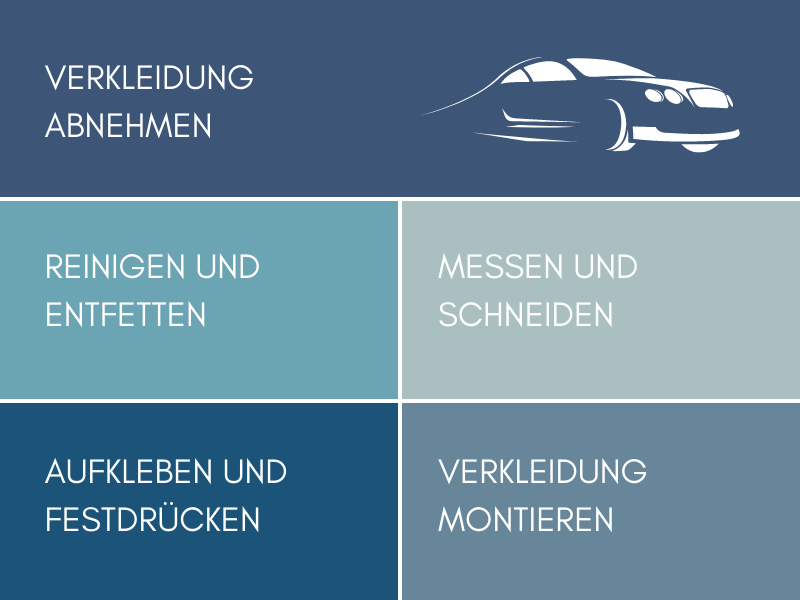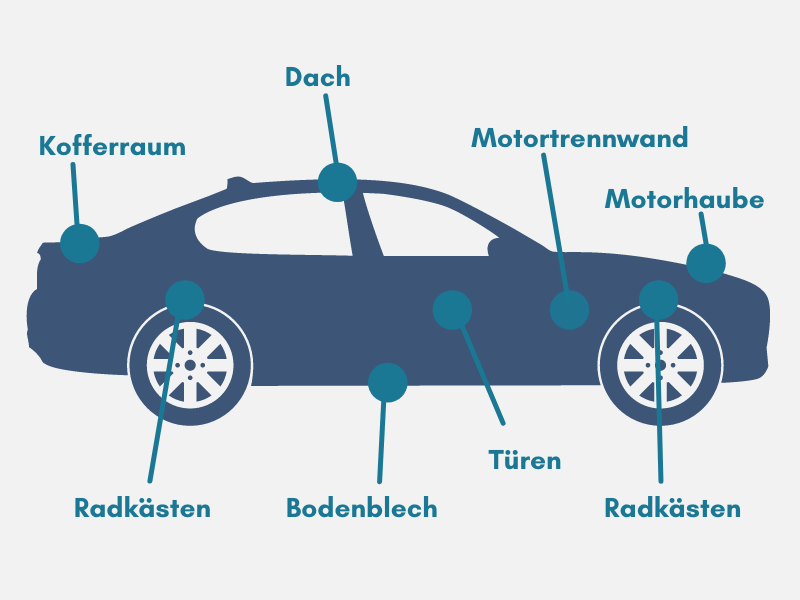Disclosure: As an Amazon Associate I earn from qualifying purchases.
Too much noise in the car can be very stressful in the long run and permanently spoil driving pleasure.
Short distances in the city are usually not a problem, but the noise is clearly noticeable in a very unpleasant way, especially when driving longer distances on the motorway or overland.
This can be problematic not only for frequent drivers.
With targeted sound insulation in the car, however, you can often achieve a lot afterwards.
Why is it so loud in the car?
The noise that penetrates the interior when driving a car has very different causes. Essentially, we are dealing with a mixture of airborne and structure-borne noise.
Noise is not only transmitted via the air, but also via the body, engine, axle and other mechanical parts of the car.
On the one hand, there are the engine noises, the exhaust noises, the rolling noises of the tires, as well as the airflow and, in addition, the ambient noise.
Insufficient insulation between the engine and interior can also be a problem and lead to more noise inside the car.
However, the typical roaring and vibrating caused by the sheet metal construction of the individual components of the car is also very unpleasant.
Such a roar is often clearly audible, especially at high speeds on the autobahn.
How loud is it in the car?
How loud it really is in the interior of a car naturally depends on many different factors.
Manufacturer, model, year of construction, road surface, tires and of course the speed all play a role here.
If you want to know exactly how loud it is inside your car, we recommend a sound level meter to measure the volume .
If you take a look at some published measured values, you will find that at high speeds of 160 km / h and more, values of over 70 dB are often measured.
That is quite remarkable.
You can find a nice overview of some of the loudest and quietest cars at Auto Bild .
The interior noises at different speeds are also given there.
What are the consequences of a high level of noise in the car interior?
The volume inside the car increases with speed. In some cases, alarmingly high values are measured here.
It has long been known that noise can make you sick.
However, too much noise in the interior of the car is particularly critical, as noise makes you tired in the long run and lets you lose concentration. Headaches can also occur.
In general, noise affects performance.
As a driver, however, you don’t need any of that, as maximum concentration is required here.
But passengers also suffer from too much noise in the car. Conversations are difficult and the car radio can no longer be properly understood.
So there are many good reasons to reduce noise in the car.
What a vehicle noise insulation can achieve
With good vehicle insulation, you can achieve amazing results.
Many hobbyists are pleasantly surprised by the excellent results after installing Alubutyl mats.
Typical driving noises, such as those generated by the engine, exhaust and tires, can be reduced with clever insulation.
The annoying roar, clatter and vibration of the sheet metal construction can also be significantly reduced.
This makes conversations easier and makes the car radio easier to understand.
Improve the sound of the car sound system

Many a motorist does not want to primarily combat external noise with vehicle insulation, but rather improve the sound in the car without having to buy a new sound system.
This is also possible with insulation.
If there are car speakers in the doors, this should also be started at this point.
Loudspeakers in the doors are problematic because car doors have some features that are not conducive to good sound.
Because they are hollow, have interior panels made of plastic (in old cars even made of cardboard) and often lack suitable insulation. In addition, they can easily start vibrating and thus negatively affect the sound.
In order to improve the sound in the car, the doors should be insulated. With a well-insulated car door, you can actually make significant improvements in terms of sound.
The entire interior acoustics are also more pleasant and clearly benefit from this measure.
Which material is suitable for car sound insulation?
If you look around which materials are exceptionally good for sound insulation in the car, you mainly come across two different products.
Namely on insulation mats made of alubutyl and bitumen insulation mats.
Alubutyl insulation material
Alubutyl is particularly often used for sound insulation in cars. This is a self-adhesive film made of butyl rubber and an aluminum carrier film.
The Reckhorn ABX Alubutyl insulation material, which you can find here on Amazon * , is particularly popular and is often used.
Alubutyl anti droning mats have several positive properties.
On the one hand, Alubutyl has a high insulating effect and can also improve the sound inside the car.
In addition, the self-adhesive film has a high adhesive effect and is easy to process. Commercially available scissors or a cutter knife (carpet knife) can be used for cutting.
In addition, Alubutyl scores with its lighter weight than many other comparable insulation materials and can be pasted over several times without any problems.
These properties make Alubutyl the perfect do-it-yourself solution for car noise insulation.
With a little manual skill, the material can simply be attached yourself without having to hire a specialist.
However, you should wear gloves when working with alubutyl, as it is easy to cut yourself on this material.
Bitumen anti droning mat
Bitumen insulation mats are also suitable for car noise insulation. These mats are also available self-adhesive, so that easy processing is also guaranteed.
These mats are also often used for sound deadening in the household area.
A combination of alubutyl and bitumen is also possible.
Here you can find bitumen insulation mats on Amazon * .
Alubutyl processing

Alubutyl is usually quite easy to process. Also, not many aids are needed if the mats are self-adhesive.
Remove the panel
Once you’ve decided which part of the car to start with, for example the doors, the first thing you need to do is remove the relevant panel.
To find out how to do this, you should first and foremost take a look at the instruction manual of your car.
But you can also usually find many helpful tips in various car forums on the Internet. Be careful in any case, as you will of course have to reattach the cladding after the alubutyl installation.
This work is usually easier with an interior lining release lever or a professional lever tool like this one here at Amazon * , with which the retaining clips can also be released.
cleaning
When you have removed the paneling, you must first thoroughly clean or degrease the sheet metal surfaces to be glued, so that the Alubuty also holds well.
For example, you can use a silicone remover, degreaser, brake cleaner or simply isopropanol alcohol.
Measure and cut
Now you should roughly measure the areas to be glued and cut out suitable alubutyl pieces.
If you want to be very specific, you can first cut out patterns from paper and then transfer them to the alubutyl.
In general, however, the Alubutyl mats are very flexible and can be brought into good shape directly during processing.
Normal household scissors are sufficient for cutting. Keep in mind, however, that your scissors can get blurred quite quickly when cutting alubutyl.
A carpet knife is also ideal.
In addition, you should definitely remember to wear work gloves, as the cut edges are very sharp.
Attach
In the last step, the alubutyl pieces are now attached. To do this, of course, you first have to remove the protective film and press the pieces firmly against the sheet metal so that they stick well and permanently.
The best thing to do is to first remove the protective film from one corner, stick this corner on and then pull the protective film off piece by piece while you press the pieces firmly on.
The use of a painter’s roller has proven to be effective.
Of course, this works particularly well when you work in pairs.
Tip: If you heat the alubutyl before attaching it, the processing goes particularly well, as it makes the material softer. You can use a hair dryer for this, for example, or simply put the mats in the sun.
Incidentally, it is not a problem if individual pieces overlap.
If you have insulated your car doors with Alubutyl, you should first check that everything is still working as intended before you reattach the interior trim.
Then that was it.
Where does car soundproofing make sense?

Not everyone has the same requirements for sound insulation in a car. And you can’t or don’t want to work on every component yourself.
Nevertheless, there are some typical places where soundproofing in the car makes particularly sense and is effective.
These positions are:
- In the car doors
- Engine Hood
- In the trunk
- Engine partition
- Inside of the car floor
- Wheel arches inside
- Car roof inside
The easiest thing to do, however, is to start with the car doors. Because you can already achieve a lot with that.
What are manufacturers doing to reduce noise in cars?
Of course, the car manufacturers have also recognized the problem and are trying various measures to reduce the noise in the interior.
These measures can be very different.
Different ideas are used, such as aerodynamic exterior mirrors, insulating foils on the windshield, better seals on doors and windows, better insulation between the engine and interior and even active noise suppression systems that work similarly to noise canceling headphones to reduce noise.
Despite these measures, the insulation with Alubutyl anti droning mats is still very popular and effective, as this can be done very specifically and individually.
Noise insulation car conclusion
With professional vehicle sound insulation with good alubutyl insulation material, you can even turn a clattering tin can into a pleasant-sounding and significantly quieter car interior.
And car speakers in the doors also benefit tremendously from such treatment.
In addition, the material is easy to process and you don’t have to be a qualified specialist to insulate your vehicle with it.
The noise in the interior decreases, the interior acoustics improve and satisfaction increases.
What more do you want?
Disclosure: Amazon and the Amazon logo are trademarks of Amazon.com, Inc, or its affiliates.



